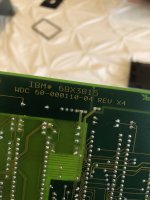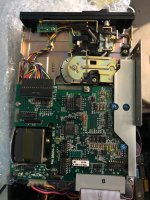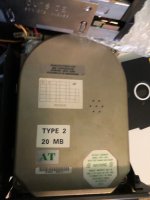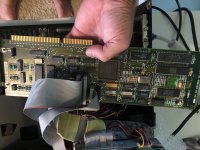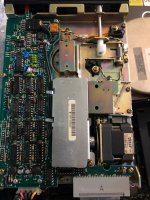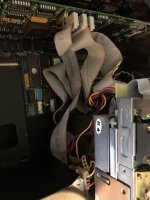Springbok
Experienced Member
It's been a very long time since I posted.
I had a 5162 in storage that I have just pulled out. I had a USB floppy emulator plugged in, but that seems to have failed. If I leave it connected, the 5162 won't power one. Remove it and it does. It's OK. I don't need it.
I now have 2 drives:
1) 360KB Alps DFC222B02A
2) 1.2MB IBM YD-380
The PC also has a 20MB Sega HD
The controller card is an IBM 68X3815
The card has 2 34 pin connectors and a 20 pin.
So as mentioned.. I keep getting Disk 602 Errors. I used to know how to fix these, but lost that knowledge, and I am pressed for time. So hoping someone here can guide me.
Both floppies have jumpers for D0-D3. I seem to recall that these need to be set. Can you perhaps tell me to what? The 1.2 also has a jumper next to D3 called M, which also has a jumper on it.
Also.. the HD used to boot, but no longer does. It goes straight to basic. One more thing. The disc does not seem to read the floppy so I can't run setup.
The cables are twisted cables. I have attached pics. Any help would be appreciated. Thanks
I had a 5162 in storage that I have just pulled out. I had a USB floppy emulator plugged in, but that seems to have failed. If I leave it connected, the 5162 won't power one. Remove it and it does. It's OK. I don't need it.
I now have 2 drives:
1) 360KB Alps DFC222B02A
2) 1.2MB IBM YD-380
The PC also has a 20MB Sega HD
The controller card is an IBM 68X3815
The card has 2 34 pin connectors and a 20 pin.
So as mentioned.. I keep getting Disk 602 Errors. I used to know how to fix these, but lost that knowledge, and I am pressed for time. So hoping someone here can guide me.
Both floppies have jumpers for D0-D3. I seem to recall that these need to be set. Can you perhaps tell me to what? The 1.2 also has a jumper next to D3 called M, which also has a jumper on it.
Also.. the HD used to boot, but no longer does. It goes straight to basic. One more thing. The disc does not seem to read the floppy so I can't run setup.
The cables are twisted cables. I have attached pics. Any help would be appreciated. Thanks

